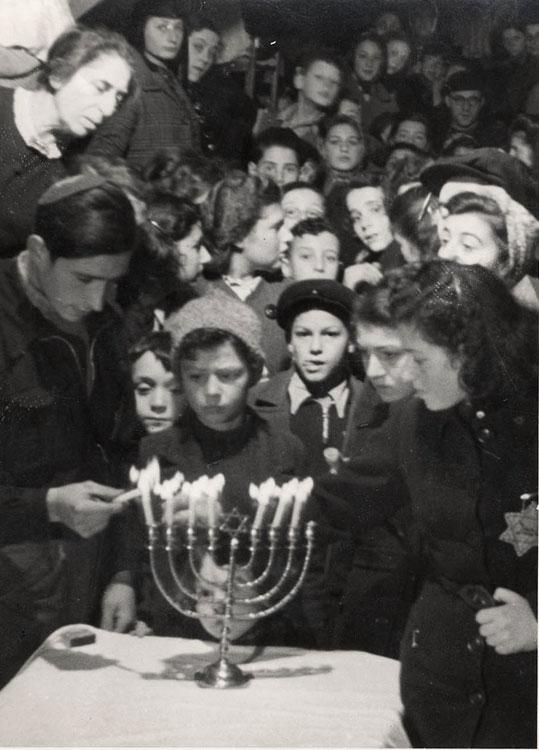In the midst of this reality of constant deportations, idealistic youngsters took care of the education of the youth in the camp, and even established a youth movement for them. They would organize activities and ceremonies on the Jewish holidays, including candle-lighting ceremonies on Hanukkah. In the photograph we see counsellor Leo Blumensohn lighting Hanukkah candles with children and youth in the camp.
The Westerbork camp was established by the Dutch government, in order to centralize Jewish refugees from Nazi Germany. The first refugees were brought there in October 1939. One of them was Leo Blumensohn, born in Frankfurt, who escaped to the Netherlands after the Kristallnacht pogrom. He was assigned to forced labor building the camp itself.
By early 1940, 60-70 Jewish teenagers who had emigrated from Germany were arrested and sent to Westerbork. Most of them were from assimilated households, and few had received a Jewish or Zionistic education at home. In March 1940, Blumensohn set up a religious Zionist youth movement, in order to give these youngsters direction and content.
In May 1940, Germany occupied the Netherlands, and in late 1941, Dutch Jews began to be arrested and sent to Westerbork. The youth detained in the camp felt cut off from the world and suffered from the difficult living conditions in the camp. Blumensohn wrote:
There arose an urgent need to provide the youth with structure, on the one hand to give them something interesting to do in their free time… and on the other hand to …show them that we, as "subhumans", marked Jews, with our age-old history and literature, that we are the cultured, ethical ones.
Amongst the prisoners at Westerbork were teachers, rabbis and informal educators, who established a school and a youth movement for the children and youth. Blumensohn relates:
We cultivated a feeling of partnership by making things together, having singalongs, and creating a choir that eventually consisted of some 250 children. We provided moral support through lectures, mainly on Jewish topics, events from the Bible and explanations about the Jewish holidays… which as far as possible we tried to observe. It gave us great satisfaction to see how enthusiastically the kids eventually observed these holidays, and how they devoted all their free time to preparations. Passover seders were inspirational events, and in anticipation of Sukkot, materials for building the Sukkah were obtained with great difficulty, and the children put together the Sukkah in a beautiful joint effort the likes of which I haven't seen to this day. But the somber holidays also left an indelible impression on the children's spirits. They took Yom Kippur seriously, and undertook to mend their ways during the year. In this way, we brought the children who came from assimilated homes closer to religion and its ideas. We didn't neglect their general education either. We organized evenings and lectures on Hermann Hesse, Stefan Zweig, Mendelssohn and others.
In the summer of 1942, the Germans started deporting the Jews from Westerbork to the extermination camps in eastern Europe. Many of the youngsters were separated from their parents, and many of the parents that remained in Westerbork were preoccupied with the difficulties of daily life and the fear of impending deportation, and could not worry about their children's educational needs. In spite of this situation, and the constant fear in the air, the teachers and counsellors continued to provide the youth with organized lessons in the camp school, complete with exams and grades, lectures, outings and sports activities.
Another hurdle was the lack of permanence among the organized youth, who sometimes only stayed at the camp for a matter of days or weeks, and were constantly being replaced. We could only equip those children who stayed for such a short time with a few Hebrew songs, and it was touching to see those same unfortunate children, crammed into the cattle cars at the moment of deportation to an unknown future, earnestly singing those songs. (Blumensohn)
On Hanukkah 1943, youth movement activists lit the Hanukkah menorah in the camp. This photograph was taken on the seventh night of Hanukkah. Bumensohn lit the candles and recited the blessings.
In the Westerbork youth movement chronicle, Marietta Duschnitz wrote:
Infectious diseases broke out around us, and a strict curfew was imposed on us… only in late December [1943], were we permitted to slowly renew our activities. After such a long break, and so many disappointments, we joyfully threw ourselves into planning the upcoming Hanukkah holiday, and devoted a great deal to thought into how we could observe it best. Giving joy to others is the greatest joy of all. Thus we alighted on the idea to prepare toys for all the children in the camp.
The chronicle was preserved in two copies. Leo Blumensohn took one copy with him when he was deported to the Terezin ghetto. In September 1944, he was deported to Auschwitz, where he lost the copy. From there, Blumensohn was sent to the Gleiwitz labor camp. In January 1945, he was forced on a death march to the Blechhammer concentration camp, where he was liberated in late January by the Red Army.
The second copy of the chronicle survived in the Netherlands. After the Holocaust, Blumensohn returned to the Netherlands and retrieved the chronicle. He ran a home for young Holocaust survivors from Buchenwald, and immigrated to Eretz Israel (Mandatory Palestine) in 1947, taking the chronicle with him.







